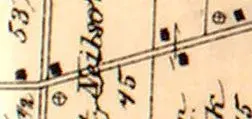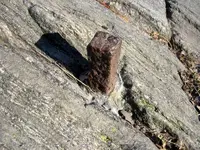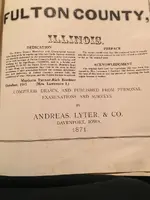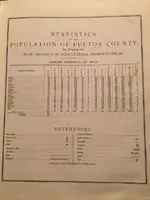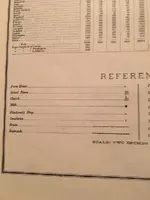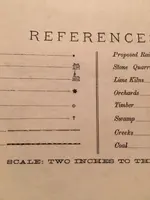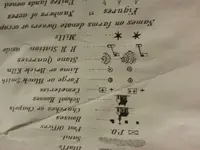You are using an out of date browser. It may not display this or other websites correctly.
You should upgrade or use an alternative browser.
You should upgrade or use an alternative browser.
Map symbol
- Thread starter pepperj
- Start date
- #21
Thread Owner
Water Well?
I was thinking the same later on today that these might be a water well for horses.
Um... Not a well.
Wells were mostly spelled out "well" Spring" etc...
IF abbreviated... "W".
Now I said MOSTLY". heh
I haven't seen it spelled out on these maps.
The mines are marked by description Lead, iron, phosphate.....
Amazon Forum Fav 👍
Upvote
0
Anduril
Bronze Member
- Joined
- Aug 31, 2015
- Messages
- 1,239
- Reaction score
- 1,602
- Golden Thread
- 0
- Location
- South Florida
- Detector(s) used
- Garrett GTI-2500
- Primary Interest:
- Metal Detecting
I think those are cellphone towers. 
Seriously though..., there are two such symbols shown on the small section of map you've presented.
My suggestion would be to locate several others on the same map and then see if you can make more sense out of them based on their positioning to other landmarks, roads, etc..
You might even get lucky and be able to decipher the mark via a Google Earth search, if the area is not too disturbed since the map was created.
You do have to think in terms of the 1870's though...

Seriously though..., there are two such symbols shown on the small section of map you've presented.
My suggestion would be to locate several others on the same map and then see if you can make more sense out of them based on their positioning to other landmarks, roads, etc..
You might even get lucky and be able to decipher the mark via a Google Earth search, if the area is not too disturbed since the map was created.
You do have to think in terms of the 1870's though...
Upvote
0
relic lover
Bronze Member
- Joined
- Jul 4, 2006
- Messages
- 2,212
- Reaction score
- 1,310
- Golden Thread
- 0
- Location
- Western PA
- Detector(s) used
- Minelab Explorer SE With a plethora of coils
- Primary Interest:
- All Treasure Hunting
The maps I have from that era have some of the schools marked with that symbol. The rest of the schools are just a dark Square. I have always wondered why some of the schools were marked this way and others not. Somebody mentioned a church maybe that's it schoolhouse / church
Upvote
0
- Joined
- Aug 19, 2014
- Messages
- 39,000
- Reaction score
- 143,641
- Golden Thread
- 0
- Location
- Tarpon Springs
- Detector(s) used
- JW 8X-ML X2-VP 585
- Primary Interest:
- All Treasure Hunting
Wow...
Surprised this has not been "solved"...
Welp...
Since it seems that my first thought of a church has been "rejected" by many on this thread...
I went back into a search mode for you pepper...
And found this... here is one more suggestion...
Here is a legend from a map from this period that depicts this symbol in 1810...
denoting a "cotton factory"... AKA a "mill" IMO...
Seems that perhaps cotton "milling" may have been going on in this area...
At first I thought that this did not make sense beings the general area is not cotton related... as far as "growing".
But textiles.

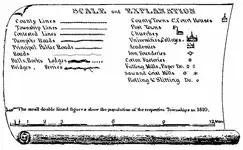
Surprised this has not been "solved"...
Welp...
Since it seems that my first thought of a church has been "rejected" by many on this thread...
I went back into a search mode for you pepper...
And found this... here is one more suggestion...
Here is a legend from a map from this period that depicts this symbol in 1810...
denoting a "cotton factory"... AKA a "mill" IMO...
Seems that perhaps cotton "milling" may have been going on in this area...
At first I thought that this did not make sense beings the general area is not cotton related... as far as "growing".
But textiles.


Upvote
0
- #27
Thread Owner
Wow...
Surprised this has not been "solved"...
Welp...
Since it seems that my first thought of a church has been "rejected" by many on this thread...
I went back into a search mode for you pepper...
And found this... here is one more suggestion...
Here is a legend from a map from this period that depicts this symbol in 1810...
denoting a "cotton factory"... AKA a "mill" IMO...
Seems that perhaps cotton "milling" may have been going on in this area...
At first I thought that this did not make sense beings the general area is not cotton related... as far as "growing".
But textiles.

View attachment 1242182
We don't do cotton in the area, but textiles or a related industry is warranted. If anything the topic brings up ideas and new information on mapping which is the survival of the mind during the winter months.
Upvote
0
- #28
Thread Owner
Because no one is sure what it is yet . One more idea is it could be the location of a survey marker, such as this survey bolt like this one found in central park from 1811? Maybe a bench mark of sort.
On the historical mapping system that's available the markers aren't shown. It's just grid pattern of concessions and the lot sizes within.
When most of the area was surveyed in the 1830's. This map doesn't have a list of people that lived in the area, just halls/churches. It was something like the movie "Fields Of Dreams" Build them and they'll come thinking.
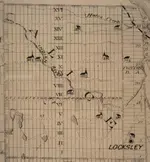
Last edited:
Upvote
0
Plug N Play
Bronze Member
- Joined
- Aug 23, 2014
- Messages
- 1,315
- Reaction score
- 3,573
- Golden Thread
- 0
- Location
- California
- Detector(s) used
- De Havilland Canada DHC-7-102 Dash 7 - Fugro
- Primary Interest:
- All Treasure Hunting
When I try to figure out a small detail on a map, I look elsewhere on that map.
Helps to know the nation.
The British were everywhere during this period.
Perhaps they are camel stables in Africa ?
Maybe feeding stations in a British prison camp ?
Gathering sites for morning prayers ?
Icelandic hot springs ?
Australian tannery ?
A nation would really help.
Is this symbol in question, common throughout the map ?
Two, might be bawdy houses, bulletin boards, or dump pits ... possibilities times 100.
Fifty, might be outhouses, wells, or fruit stands ... possibilities times 100.
Do the symbols appear near waterways or railroads ?
Sawmills or gristmills come to mind.
What country or company drew up the map ?
Different symbols and styles could be researched, that way.
I think you are asking an awful lot, and providing very little, in a single, tiny speck of a map.
Helps to know the nation.
The British were everywhere during this period.
Perhaps they are camel stables in Africa ?
Maybe feeding stations in a British prison camp ?
Gathering sites for morning prayers ?
Icelandic hot springs ?
Australian tannery ?
A nation would really help.
Is this symbol in question, common throughout the map ?
Two, might be bawdy houses, bulletin boards, or dump pits ... possibilities times 100.
Fifty, might be outhouses, wells, or fruit stands ... possibilities times 100.
Do the symbols appear near waterways or railroads ?
Sawmills or gristmills come to mind.
What country or company drew up the map ?
Different symbols and styles could be researched, that way.
I think you are asking an awful lot, and providing very little, in a single, tiny speck of a map.
Upvote
0
S
stefen
Guest
Each of the o's and +'s are within properties either side of the roadway.
Therefore they are not Section markers, not grave sites, not wells, certainly cannot be salt licks, and so on.
Think about potential mapping updates such as barns or outbuildings...or rent, crop sharing or owner...
Therefore they are not Section markers, not grave sites, not wells, certainly cannot be salt licks, and so on.
Think about potential mapping updates such as barns or outbuildings...or rent, crop sharing or owner...
Upvote
0
- Joined
- Jun 16, 2014
- Messages
- 11,941
- Reaction score
- 18,119
- Golden Thread
- 1
- Location
- Northern O-H-I-O
- 🥇 Banner finds
- 1
- Detector(s) used
- F75 LTD, 1280X Aquanaut, & a Patriot (back-up/loaner)
- Primary Interest:
- Metal Detecting
The map looks to be from the late 1800's I believe mark_Todd got it right.
Upvote
0
Ant
Silver Member
I found that old map pages like the ones that we find from Sanderson Maps and other historical maps came from a book (similar to a plat book). The first place that I look for the legon of symbols for these plat book map pages is on the first or second page of the plat book. Sometimes these pages are copied from a section of a one page map too, then the legon of symbols could be on another section. I already mentioned that the map maker (author) can use any symbol, but they should make a legon index, they didn't and still don't always use generic map symbols, good luck.
Last edited:
Upvote
0
eyemustdigtreasure
Silver Member
- Joined
- Mar 2, 2013
- Messages
- 3,627
- Reaction score
- 5,631
- Golden Thread
- 0
- Location
- California
- Detector(s) used
- Fisher Gold Bug Pro
Tesoro Cibola
Nokta Pointer; Phillips SHS5200 phones
Nokta Macro SIMPLEX +
- Primary Interest:
- Metal Detecting
Crappies-n-Coins,
I think you are right.
Inside the circle, the pluses are kinda topheavy/lopsided,
like a cross is, and that usually indicates a graveyard,
and a church is a box with cross inside (outside?)
Let's face it, I'm not good a old map symbols...!
(any other guesses, guys?)
~eyemustdigtreasure
I think you are right.
Inside the circle, the pluses are kinda topheavy/lopsided,
like a cross is, and that usually indicates a graveyard,
and a church is a box with cross inside (outside?)
Let's face it, I'm not good a old map symbols...!
(any other guesses, guys?)
~eyemustdigtreasure
Upvote
0
- #35
Thread Owner
When I try to figure out a small detail on a map, I look elsewhere on that map.
Helps to know the nation.
The British were everywhere during this period.
Perhaps they are camel stables in Africa ?
Maybe feeding stations in a British prison camp ?
Gathering sites for morning prayers ?
Icelandic hot springs ?
Australian tannery ?
A nation would really help.
Is this symbol in question, common throughout the map ?
Two, might be bawdy houses, bulletin boards, or dump pits ... possibilities times 100.
Fifty, might be outhouses, wells, or fruit stands ... possibilities times 100.
Do the symbols appear near waterways or railroads ?
Sawmills or gristmills come to mind.
What country or company drew up the map ?
Different symbols and styles could be researched, that way.
I think you are asking an awful lot, and providing very little, in a single, tiny speck of a map.
The flag under my avatar might have been a given, but I guess one should take something for granted. The mapping is for Ontario Canada
Upvote
0
- Joined
- Apr 24, 2010
- Messages
- 12,923
- Reaction score
- 27,656
- Golden Thread
- 1
- Location
- Upper Canada 🇨🇦
- 🥇 Banner finds
- 1
- 🏆 Honorable Mentions:
- 3
- Detector(s) used
- XP Deus, Lesche Piranha 35 Shovel & 'Garrett Carrot'
- Primary Interest:
- Relic Hunting
Looks like they only thing left to do is meet at the site and see what pops up! 
Dave

Dave
Upvote
0
Crappies-n-Coins
Bronze Member
Well, depending on the distance, there is always the option of doing a Google Earth/map overlay.
Upvote
0
Dewayne Hight
Tenderfoot
- Joined
- Sep 2, 2015
- Messages
- 7
- Reaction score
- 3
- Golden Thread
- 0
- Primary Interest:
- All Treasure Hunting
Possibly the old symbol for surveyor's bench mark before standardization. I've seen them on some old maps on peaks and landmarks
Upvote
0
Dewayne Hight
Tenderfoot
- Joined
- Sep 2, 2015
- Messages
- 7
- Reaction score
- 3
- Golden Thread
- 0
- Primary Interest:
- All Treasure Hunting
churches are a solid box with a cross on top
Upvote
0
ironhorse
Silver Member
- Joined
- Oct 13, 2009
- Messages
- 3,886
- Reaction score
- 5,617
- Golden Thread
- 2
- Location
- East Dirtyville
- 🥇 Banner finds
- 2
Upvote
0
Similar threads
- Question
- Replies
- 8
- Views
- 610
Users who are viewing this thread
Total: 1 (members: 0, guests: 1)

